7 BLW Mistakes I Made So YOU Don't Have To!
- Dangling feet in feeding table - we had a SUPER COOL LOOKING quadruplet feeding table...that was also totally dangerous because it didn't have a footrest and the babies' feet were dangling. I'm sharing how I would DIY that feeding table to make it safer for babies to eat in.
- Feeding directly on the table - seemed to me like putting plates or bowls out was just making more dishes. But actually putting the food directly on the tray or the table can really frustrate babies early on in feeding. I'm sharing how a plate or bowl suctioned to the table helps facilitate independent eating.
- Wiping baby's face - neat freak, big time. I thought if I “cleaned as I go” the post-BLW mess would be less. But constantly wiping your baby during a meal is a really negative sensory experience. Babies NEED to experience what it feels like when food or liquid drips out of their mouth.
- Not practicing with an open cup - did NOT know that the progression wasn't breast/bottle to sippy cup to baby eventually learns how to drink out of an open cup. I never did an open cup early on with my quadruplets, but I'm sharing the totally opposite experience I had when I did do open cup training early on with my twins after that.
- Comparing my baby to other babies - we all do. But what they say is true, “Compare and despair”. I'm sharing how 1 of my quadruplets would NOT participate in eating during the first 6 weeks of BLW and it stressed me out to no end because I was comparing him to other babies namely his 3 quadruplet siblings instead of respecting his individuality.
- Passing on purees - big misconception about BLW is that it means no purees. Um….wrong. Purees are an important texture for babies to learn how to eat...they're just not the ONLY texture babies can eat. And I'm sharing how you can offer baby a pre-loaded spoon and they learn to self-feed purees early on, which is completely compatible with the self-feeding approach of BLW.
- Stressing when my baby didn't eat - If you don't have Ellyn Satter's “Division of Responsibility in Feeding Theory” burned to the inside of your brain, I hope this episode will help you do it. I didn't KNOW that it's not my JOB to make my baby eat or to eat a certain amount. If we can stick to our jobs in feeding, stayin our lane in feeding, we realize that babies are ultimately in charge of how much they eat or even whether they eat.
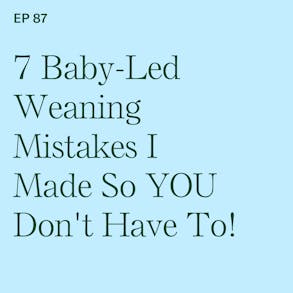
LISTEN TO THIS EPISODE
Episode Description
We had 7 kids in 3.5 years and I have made a LOT of mistakes in my brief parenting journey. Before I changed my dietitian career to specialize in infant feeding and baby-led weaning I was a super stressed out mom trying to figure BLW out on my own to feed my quadruplet babies.
It was hard for me to narrow the list of BLW mistakes I made when I was starting out down to just 7. I went through my phone, back to the first week that the quads started BLW and I am just cringing because I made SO MANY MISTAKES. My quads are fine, they lived through it...but if I can save you some heartache or stress or help you reverse an unsafe feeding practice early on in your BLW journey, well that’s my intention with this episode.
Join me as I walk you through 7 BABY-LED WEANING MISTAKES I MADE SO YOU DON’T HAVE TO! I’m getting kind of personal in this episode, but looking back I wish I had a resource like this when I was starting solids as a new mom and I hope you find it helpful (...but also a reminder that we’re all human, we all mistakes and we can all learn from each other and OUR collective mistakes!)
Links from this Episode
- Baby-Led Weaning with Katie Ferraro program with the 100 First Foods™ Daily Meal Plan, join here: https://babyledweaning.co/program
- Baby-Led Weaning for Beginners free online workshop with 100 First Foods™ list to all attendees, register here: https://babyledweaning.co/baby-led-weaning-for-beginners
Other Episode Related to this topic
- Episode 40: 6 Reasons to Skip the Sippy Cup with Dawn Winkelmann, MS, CCC-SLP is here.

Latest Episodes
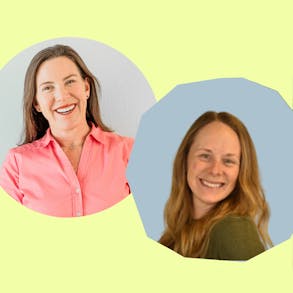
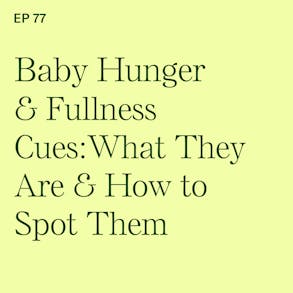
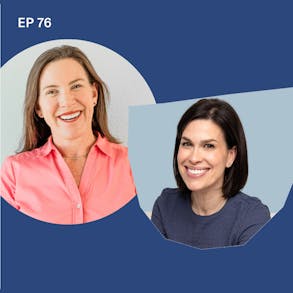
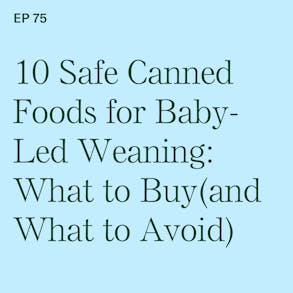

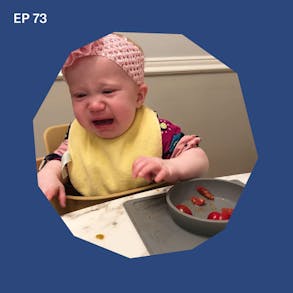
Katie Ferraro (0s):
So I went back in my phone to the very first week. The quadric would start at baby led weaning, and I'm cringing now at my own photos and videos. So many bad practices. If I can save you some heartache or possibly reverse some unsafe feeding practices for you, that's why I'm sharing my own BLW mistakes. Hey, there I'm Katie Ferraro, registered dietitian, college nutrition professor, and mom of seven specializing in baby led weaning here on the baby led weaning made easy podcast. I help you strip out all of the noise and nonsense about feeding, leaving you with the confidence and knowledge you need to give your baby a safe start to solid foods using baby led weaning.
Katie Ferraro (42s):
Hey guys, welcome back. Now today's episode is a little on the personal side, but I wanted to share seven baby led weaning mistakes I personally have made so that you don't have to make the same mistakes too. And these are all real life mistakes I made. It was like a soul searching process to go through like old pictures and be like, oh, that was wrong. That was wrong. And literally when I think back on them or see the pictures or videos from that time when I was doing baby led weaning with it, it was six of my seven kids. Now I cringe because I do infant feeding full-time and I see all sorts of dangerous feeding practices all the time in my line of work as a dietitian specializing in baby led weaning. But of course I have no intention of calling anyone else out or shaming anyone else for how they choose to feed their baby.
Katie Ferraro (1m 23s):
And that's, I think that's unique in the world of baby led weaning because if you know anything about it, it's a totally judgy area of parenting. And I have worked very hard to not perpetuate that idea that people who work in or endorse baby led weaning are judgmental. I am here to celebrate all of the things that babies can do and to teach parents how to help them learn how to do that safely. So if people do ask me for feedback, I will certainly give it, but I'm not in the business of providing unsolicited criticism about anyone's infant feeding practices or preferences. You'll never, however, see a photo on my feed or in my stories or in any of my content or workshops or courses that ever shows a baby being fed in a dangerous position or a dangerous food, unless I have prefaced it with "Hey, I staged this picture to show you, this is exactly what you don't want to do".
Katie Ferraro (2m 8s):
And I also never reshare any videos or pictures that I'm tagged in. If it shows a being baby being fed unsafely. My DMS in Instagram are out of control, but sometimes people be like, you never reshare my stuff and I don't have the heart to be like, because every single picture you're doing something dangerous or babies can eat that food. So I just kind of let it slide, but I do want to broach some of these topics. So it makes it easier to share mistakes and feedings that I have made. And I'm going to do that in order to reinforce the idea that A, we are all human and we make mistakes, but B we can learn from our mistakes. So for the mistakes that are totally preventable, I'm going to give you a few tips that you can employ in your own family with your own baby. If you're just getting started with solid foods. And before I get going, I just want to say that if you've made some of the same mistakes that I did that I'm about to talk to, or if you're currently making them, it's not a big deal.
Katie Ferraro (2m 54s):
No one's saying you're a bad mom or dad or caregiver. We're here to learn our babies. Learning how to eat is continual process. We can always make adjusting along the way. If you notice that you're getting stuck or something isn't working. And if that's because you're doing something wrong, how can we write that wrong? Hang tight too, because I'm going to be sharing some resources at the end of this podcast episode, where you can learn more about giving your baby a safe start to solid foods. So I hope you enjoy this episode. It's all about seven baby led weaning mistakes I personally really made so that you don't have to let's get started. All right. Mistake number one. Okay. So I shared that the way that I organize this episode was by going back to the beginning, my phone, thank God for pictures in your iPhone. Organized by date. I struggled with spoon feeding, my oldest daughter, when she was like six or seven months old, the height that my feeding frustration, I found out we were pregnant with quadruplets.
Katie Ferraro (3m 41s):
And I remember thinking like normal people would think like, oh, how are you going to teach four babies how to drive at once? Or how are you gonna pay for college? I remember thinking like how in the world am I going to feed four babies at one time when I can't even feed the one baby that I have at home. So fast forward, when it came time for the quads to start solid foods, I threw myself wholeheartedly into baby led weaning, figured out how to do it. Used my nutrition background in my position as a professor basically I read every single article about self-feeding that I could get my hands on, but put together a system that worked for our family. But I made a lot of mistakes along the way. So before I worked full-time in baby led weaning. I was a normal mom with quadruplets. I don't know if that's normal, but they were premature. So we waited until their six month adjusted age. And I followed a couple other quadruplets moms.
Katie Ferraro (4m 22s):
And I remember seeing one feeding her babies in a feeding table. So it's like preschool use these tables to feed a bunch of babies at once. Kind of like an assembly line. Again, I knew nothing about infant feeding at that time I was doing fully adult nutrition. So these like feeding tables looked awesome. I ordered one online. It showed up. I'm like, dude, this is so cool. You can put all the babies in he's like you basically dropped them in these four buckets. The visual on it was amazing. I have to admit like the visual of four babies sitting at a table. Everyone was like, that's so cool. It looks it's really cool. It's not why I did it. I did it initially for convenience and ease and because I didn't have room for four high chairs. And the problem with feeding table now looking back is that the baby's feet were dangling. That's the first mistake I made was I was feeding my babies in a table where their feet were dangling underneath their feet were not resting flat on a foot rest.
Katie Ferraro (5m 4s):
So many of you are aware that baby's feet resting flat on a foot rest is imperative for helping to support their core and to facilitate a safe swell. So I use the table for a long time. And then when I gave it away, I did give it away to another quadruplet mom with the caveat. Like there are some ways you can put a stool underneath with boxes on it to make it like a flat surface for the baby to rest their feet on if you want to. Most people wouldn't. So to that extent, but mistake number one was dangling feet in the feeding table. How can you correct that by purchasing a high chair that has an adjustable foot rest, that your baby's feet rest flat on or by DIY-ing it and making your own foot rest. Like I could have brought a coffee table in and put some stuff underneath it so the baby's feet were resting flat and then the quadruplet feeding table would have been safe.
Katie Ferraro (5m 45s):
Mistake. Number two, again, looking back at pictures in the beginning, I was putting all of the quadruplets food out on the feeding table. I would like take the food avocado or banana sweet potato and put it in front of them. That is very frustrating for babies early on in the feeding process, even though they were seven and a half to eight months old adjusted age when they started solids, because they were born prematurely, they didn't have their pincer grasp. So the pincer grasp is required to pick up small pieces of food. So I knew that. So I was offered them longer pieces of food, the soft solid strips of food that we do for baby led weaning, except I wasn't setting them up for success because I was putting the food directly on the table. Now in hindsight, and what I always do now is feed the baby out of a suction silicone mat or bowl. What happens when you put the food flat on the table or flat on the chair or the tray rather, is that your baby, they have their whole hand grasp and they'll put their hands out and they'll smash the food and they'll smear it all around.
Katie Ferraro (6m 35s):
But because they don't have any barrier against which to rake and scoop the food up and out, they get frustrated and they can't pick the food up. And then parents are like this doesn't work, they can't feed themselves. Let me put it on a spoon and shove it in their mouth. So in order to set the babies up for success, we want to feed out of a silicone or suction mat or bowl. So that was the second mistake that I made was feeding directly on the table or directly on the highchair. And I see it all the time. Parents putting food on the high chair, the baby smashes the food to the side of the tray, and then they give up the bowl or the mat, not only do they kind of help minimize the mess, but it really helps facilitate independent eating. The third mistake that I made. And it makes me drives me crazy. Now when I see people doing it, but I did the same thing as wiping the baby's face constantly while they're eating, I am super type A, I have to admit it like a lot of my dietitian friends know what I'm talking about.
Katie Ferraro (7m 18s):
It's kind of why you get into nutrition. Sometimes a lot of you guys might consider yourself type A, I'm a clean freak. And when I have four babies making a mess at one time, I was like, well, if I clean, as I go, it won't be so bad when it's over. Right? But here's the deal. Babies need to experience this sensation of the food dripping down their mouth or dripping onto their chest and their bib or the water, the milk, or the formula dribbling out of the side of their mouth as they're learning how to drink. That's part of the learning how to eat experience. And so when a baby is eating, like think how you would feel if you were trying to learn how to eat oatmeal, and this lady kept like coming at you with her wet wipe in between every bite, it can be a very negative sensory experience. So yeah, you want to minimize the mess and clean that food mess up as soon as the meal is done, but allow your baby to eat uninterrupted for 15 to 20 minutes and don't wipe or clean up until the meal is over.
Katie Ferraro (8m 2s):
But then yeah, go to town. That's mistake. Number three, wiping the baby constantly. As they're eating the fourth mistake that I made and give myself a break on this one was not practicing with an open cup. I did sippy cups. I just thought the natural progression, like I'd had one kid and she was still alive and drank out of sippy cups. Like I thought you just went breast or bottle to sippy cup. And then someday they learn how to drink out of an open cup. It wasn't until I had been doing baby led weaning for a long time that I recognized that sippy cups are solely for the purpose of preventing spills that's they were designed by parents. They are essentially for parents to prevent spills, a lot of other content about sippy cups. I've got a great episode with Dawn Winkelman, a speech-language pathologist who specializes in infant feeding and swallowing. She designed the open cup for EzPz.
Katie Ferraro (8m 43s):
The tiny cup in the mini cups. The episode is called six reasons to skip the sippy cup. I'll link to that in the show notes for this episode at blwpodcast.com, go there if you want to learn more about sippy cups, but I didn't do an open cup and I have to be honest. One of my primary goals was to minimize the mess at four babies at once. If they had to drink something, they sure as heck weren't going to spill it all over the place. So I did practice with an open cup with my quadruplets until I don't even know when I went on to have another set of multiples the twins a year and a half later, by then, I was full-time and infant feeding had switched to specializing in baby led weaning, definitely knew and understood the benefits of an open cup. I was working with Dawn very closely, right when her tiny cup came out for EzPz was when my quadruplets had turned eight months, my twins rather.
Katie Ferraro (9m 24s):
So I had been doing solids for about two months. And those of you guys who are just starting out, you might've heard your baby can start drinking out of an open cup starting at six months of age. I didn't get around to doing it until eight months, but that's when the tiny cup came out. And we started practicing five minutes after every single meal, which was two or three times a day. At the time when they were eight months old, by the time they turn one, they had hit that feeding milestone, which was being able to drink out of an open cup with minimal assistance. They can do it by themselves rather, but with minimal spillage. I did not do that with my quadruplets. They're fine. They can drink out of an open cup. Now I would argue they're like super klutzy, but I just didn't know about the benefits of open cup drinking and that kind of tacks onto, I feel like early on, I didn't know about the guidelines to get our babies off of bottles by the 12 month mark.
Katie Ferraro (10m 3s):
Now you can look at other guidance. Like AAP says somewhere between 12 and 15 months, some resources say 12 months, there's a lot going on at 12 months, you got to have a birthday party. You gotta get that cake and the baby. I mean, I'm not going to do off the bottle right at 12 months. But when I see babies or 18 and 20 months old, still drinking out of a bottle, we know that they are a more likely to be drinking more milk than they should be, because they're really efficient at drinking out of a bottle, right? Cause they've been doing it for 18 months. So she means her drinking too much milk, which means they're not eating enough food, which means they're not getting the right nutrition from food. And on top of extended bottle use is linked to poor tooth development, extended additional tooth decay. It also leads to delays in speech development and speech patterns. So all sorts of reasons to get our babies off the bottle.
Katie Ferraro (10m 44s):
I give myself a grace period between 12 and 15 months start that open cup at around six months of age, but you don't need to do sippy cups. So mistake number four, I would say me was not practicing with an open cup. Mistake number five. And we all have a tendency to do this, but I would compare my babies to other babies. And like, I didn't set out being like, let me find a baby who's the same age as my baby so I can see them eating better than my baby and make myself feel bad. But that's what social media will do to you sometimes. And so I remember when I was trying to figure out baby led weaning with the quadruplets. I knew that they were premature six weeks premature. They were born at 34 weeks and they were all like between two and three pounds. I did spend time in the NICU. So they had some delays and all that different delays too. So I wanted them all to start at once.
Katie Ferraro (11m 24s):
So I waited until we're sitting up relevant, all four, rather I did not have six babies at one time. I told them all that's possible. All four babies were sitting up relatively unassisted. That happened when they were like seven and a half months. So they were like around the six month adjusted age mark. But I remember one of my quadruplets, Henry, I always talk about him. I love him but to this day he is the slowest eater in our family. He put his head down on the table for the first six weeks of baby led weaning, right? So they were seven and a half months chronological age for six weeks. So when he was nine months old in his Cron age, he woke up and started like eating with the rest of the family. But I was like looking up stuff like, what does it mean if one baby doesn't eat help? My baby won't eat like every iteration of that on Google search.
Katie Ferraro (12m 4s):
And then seeing other babies who were quadruplets, who were delayed, who like were his same age and being like, God, they eat better than my baby. And that's one of the worst things you can do because you've heard the saying compare and despair. If you compare your baby to another baby, you're only gonna end up feeling bad about yourself. And it doesn't matter because all babies are different. All babies will come to their abilities to learn how to feed themselves at a different time. They're not magically going to wake up on their six month birthday and do it. And they're not going to magically know how to do all this stuff by their first year. If you don't practice with them. I remember the anguish that I caused myself by trying to compare Henry. And especially, I was just comparing them to this other three siblings. Like I had a little sample size of four, right? Like my own little test group and three of the babies who were just as premature as he was and had everything else like similar to him.
Katie Ferraro (12m 45s):
Why were they eating? And why was he not eating? And parents of multiples will know this, that there's always one baby is going to do everything faster than the other one. I know exactly which one it is. My house walked first. He sat up first. He rolled over first. He talked for us. He just does everything first and Henry, I love him to death, but he always does everything last, all babies are different and it's okay. And I wish I didn't waste time worrying about him. Now, if there truly is a problem, I am working on an episode for you guys about, you know, how to identify when a baby does need feeding therapy. Like there's certainly a point at which you're like, okay, that's not good. That's not healthy. That's not normal. But we as parents have a tendency to do it for everything. So don't look at Instagram and say, God, my baby's at age. People ask me all the time. How old is that baby? Unless the mom posted it originally, I won't say how old that baby is because it doesn't matter because all you're going to do is be like, well, my baby's eight months old and it's not drinking out of a cup that well, but I'll share, you know, babies can begin to start drinking out of an open cup at six months of age, but I don't want you to feel bad about what your baby is or isn't doing based on their age because also age guidelines.
Katie Ferraro (13m 41s):
I'm moving in my own content away from defining babies by age at six to seven months, you should do that, this or that, because what if you didn't start solid foods right at the six month mark, if you started when your baby is eight months old and it's your first week, the baby led weaning. And I say, eight month old baby should eat two to three times a day. You're going to be like, what? Because if your baby just started, they're essentially like a six month old babies. Who've been eating for eight weeks or so can begin to eat it around two to three times a day. So I want to change the conversation so that we're not tying everything to age because especially with adjusted age, prematurity babies, with different abilities and parents, sometimes don't get around to starting solid foods, right? At six months of age and some parents start way too early. So they're messing up the time and the age stuff there as well.
Katie Ferraro (14m 20s):
So again, comparing babies to other babies, huge mistake. I did it. It's number five. I hope you don't do it. Mistake number six that I made in baby led weaning was passing on the purees. I thought purees and feeding babies purees were independent from baby led weaning. I thought that purees could not successfully be combined with baby led weaning. And I still see a ton of stuff out there that mistakenly says that that all babies can not eat purees. If you do purees, you're not doing baby led weaning. Guess what? There are some foods that are naturally period forms. What about yogurt, what about unsweetened applesauce? What about hot cereals and things like oatmeal. Those are technically pureed foods. What are you going to do? Never feed them to your baby. Of course not. The problem with purees is when we put them on the spoon and the adult or the parent is pushing the spoon into the baby's mouth.
Katie Ferraro (15m 7s):
That takes away the baby's inborn ability and desire to feed themselves their foods. They can do this. We can teach our babies how to eat from a preloaded spoon starting at six months of age, you need the right type of spoon. Okay? And you need the right technique. If you want more info on this topic, I did a fabulous interview with Dawn Winkelman. Again, this the pediatric swelling expert. She designed the tiny spoons for easy peasy. On episode 64, I interviewed Dawn it's all about how to preload a baby led weaning spoon. She shows you that self-feeding technique. Well, she explains it to you because it's a podcast episode. Again, BLW podcast.com forward slash 64. You can go to that episode with Dawn. I originally thought babies don't eat purees. They certainly should eat. Purees periods are a very important texture for babies to master.
Katie Ferraro (15m 48s):
They're just not the only texture that babies can eat. So traditional spoon feeding babies tend to only eat purees and the way that they're eating the purees as they're being forced fed the purees by a spoon, that's driven by the parent or the caregiver. Baby led weaning. We preload the spoon. The baby eats the foods that are naturally in period form, but we're also offering baby simultaneously different textured foods in addition to puree. But the baby is always driving the feeding. That's the difference there. And mistake number seven that I made that I hope you don't have to is I stressed out when my baby wouldn't eat. And I know some of you guys are nodding your head wherever you are listening to this in the car, on a walk, folding laundry, doing dishes. If you are finding yourself, stressing about the quantity of foods that your baby is eating, that's not your ob.
Katie Ferraro (16m 31s):
We think about the division of responsibility in feeding theory, this is Ellyn Satter's theory. This should be the overarching mantra that drives everything you do in feeding your child from baby's first bites. Well into adolescents, you have three jobs, mom or dad or caregiver. Your job in the division of responsibility, feeding theory is to be responsible for what your child eats, where they eat and when they eat, especially early on you pick the wholesome foods you put where meaning safely seated and positioned in a highchair with an adjustable foot rest in their feet, resting flat. And then you pick what you pick, where you hit when that's mealtimes three jobs, your jobs take care of the, what take care of the win. Take care of the where and the when with mealtimes means set at mealtimes, not allowing the baby to scrape, to graze or snack or eat all day long.
Katie Ferraro (17m 12s):
We have set meal times with starts and stops, and that's when babies eat. But it's the baby's job ultimately to determine how much or even whether they eat. So if you find yourself stressing because your baby's not eating because you've been doing this for three or four weeks, remind yourself, that's not my job. My job is to put the what out there, the healthy, wholesome age, appropriate foods. My job is to do the, when meaning at meal times, my job is to do the where and make sure the baby is positioned and seated properly, but how much, or even whether your baby eats, that is not our job. And so many questions that parents ask me when they're at the height of their feeding frustration. I remember where I was with Molly. My oldest one, I was trying to spoon feed. I was freaking out because she wouldn't eat or she wouldn't eat as much as I thought, or she wouldn't eat the full two ounces of pureed peas that came in the baby food poucher jar.
Katie Ferraro (17m 55s):
I was trying to make her eat. It's not our jobs. If you find yourself stressing that your baby's not eating, take a step back and remember what your job is, your job and the division of responsibility of feeding theory has nothing to do with how much or even whether your baby eats. And if you can remember that even beyond baby led weaning, especially into those trickier stages of toddlerhood where kids, they all have some degree of picky eating. If you give your baby the good foundation for eating solid foods, they will eat when they learn to recognize and respond to their hunger cues. So please, please, please don't make that seventh mistake that I made do not stress out when your baby doesn't eat. There's always another meal later. There's always another day tomorrow. It might take a few more weeks before your baby gets the hang of it. Maybe you're having a bad week or a bad day or a bad meal.
Katie Ferraro (18m 36s):
And that's okay. It's not your job to determine how much or even whether your baby eats. So there you have it. I hope you guys enjoyed the seven baby led weaning mistakes I made so that you don't have to. I teach a free online workshop called baby led weaning for beginners. It's all about how to get your baby to eat a hundred foods without you having to spoon feed, purees or buy pouches. Everyone on the workshop gets a copy of my hundred first foods list. If you want to sign up for this week's workshop times, I've got a ton more tips in there. I shared like the worst of my mistakes today, but I've got a lot of other feeding tips and tricks that I share inside of this free workshop. You can sign up for this week's workshop times. If you go to the show notes for this episode, BLW podcast.com forward slash 87, you can find them. Bye now.
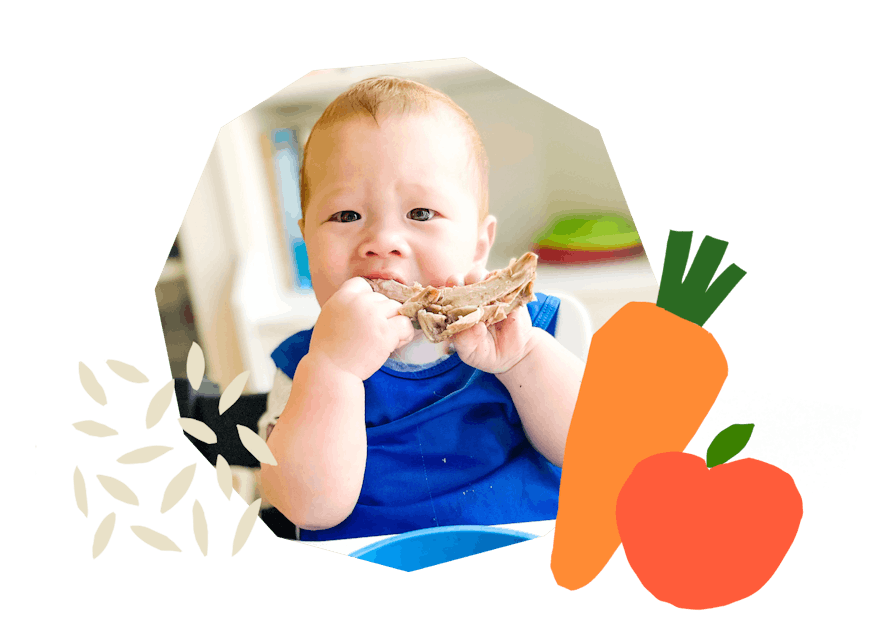
The Program Baby-Led Weaning with Katie Ferraro
A step-by-step digital program for starting solid foods safely and navigating the original 100 FIRST FOODS™ meal plan with baby-led weaning.
 EXPERT-LED, PROVEN APPROACH TO EATING REAL FOOD
EXPERT-LED, PROVEN APPROACH TO EATING REAL FOOD CONCISE VIDEO TRAININGS TO MASTER BABY-LED WEANING
CONCISE VIDEO TRAININGS TO MASTER BABY-LED WEANING 100 FIRST FOODS DAILY MEAL PLAN WITH FOOD PREP VIDEOS
100 FIRST FOODS DAILY MEAL PLAN WITH FOOD PREP VIDEOS
Baby-Led Weaning for Beginners Free Workshop
Is your baby ready to start solid foods, but you’re not sure where to start? Get ready to give your baby a solid foundation to a lifetime of loving real food…even if you’re feeling overwhelmed or confused about this next stage of infant feeding.
Get baby-led weaning recipes and tips delivered to your email inbox.

